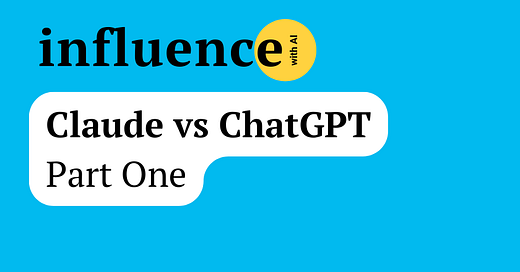How do Claude and ChatGPT compare in writing a white paper? (Part 2)
Plus, a 14-prompt chain for writing a detailed policy white paper
Happy Saturday!
This week I continue to assess the differences between Claude and ChatGPT.
Last week I looked at how the two models compared in their analysis and critical thinking skills. I found that the two models performed similarly and wasn’t prepared to declare a winner or a loser. In fact, I felt that using both for the same task give me a wider perspective to consider.
This week, I put them through their paces by having them write a hypothetical white paper on reforming the tax code in Canada. On paper, this is where Claude should shine, as it tends to produce more natural-sounding writing.
However, ChatGPT has built-in web search capabilities which equips it to find recent sources.
Unlike last week, I have a clear winner for this experiment. Take a look:
The Prompts
For this experiment, I wanted to generate a white paper to explore alternatives to income taxes, with an eye to helping younger Canadians cope with housing and affordability costs.
Here are the sequence of prompts I used to get to an end product:
Prompt 1: Conduct baseline research
TOPIC=Alternatives to Income Taxes as a source of government revenue, INDUSTRY=Financial services, AUDIENCE=20-45 year old Canadians.
Use web search to identify 5-7 key challenges or pain points related to challenges high income tax rates pose for younger Canadians, especially with current affordability challenges. Summarize each in 1-2 sentences.Prompt 2: Find relevant trends
Research and list 3-5 current trends or innovations from other jurisdictions that have explored other forms of taxation. Include statistics or data points to support each trend.Prompt 3: Develop a compelling title
Develop a compelling title for the white paper that incorporates the need for tax reform in Canada and appeals to young Canadians. Create 3 options and briefly explain the rationale for each.Prompt 4: Draft executive summary
Once you pick your working title, move on to the executive summary:
Craft an executive summary (250-300 words) that outlines the white paper's main points, key findings, and value proposition for young Canadians.Prompt 5: Create a detailed outline
Create a detailed outline for the white paper, including: 1. Introduction 2. Background/Context 3. 4-6 main sections addressing key challenges and solutions 4. Case study or real-world example 5. Future outlook 6. Conclusion and recommendations. Provide a brief description of the content for each section.Prompt 6: Write the introduction
Write the introduction (500-750 words): 1. Hook the reader with a compelling statistic or scenario 2. Provide context for tax reform in Canada 3. Clearly state the white paper's purpose and what young audiences will gain 4. Include a brief overview of the main sections.Prompt 7: Build out the main sections
For each main section: 1. Start with a clear subheading 2. Present the challenge or issue 3. Provide in-depth analysis, including data and expert insights 4. Offer potential solutions or best practices 5. Include relevant graphics, charts, or diagrams to illustrate key points Aim for 1000-1500 words per main section.You will then need to prompt the model to build out each section, one at a time:
Please continue to write each section. You can write each section one at a time.Keep reading with a 7-day free trial
Subscribe to Power Shifts to keep reading this post and get 7 days of free access to the full post archives.




